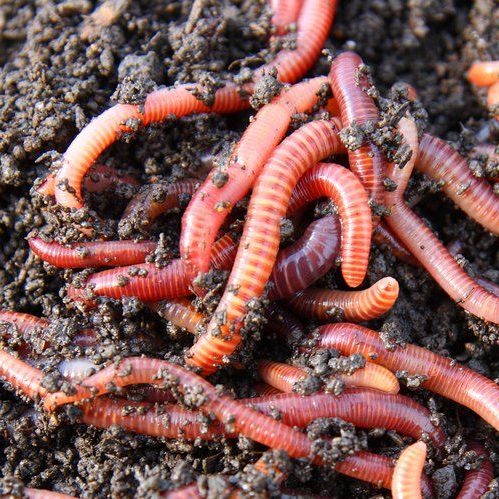Red Wigglers: The Unsung Heroes of Organic Waste Recycling
Red wigglers, or Eisenia fetida, act as essential agents in the organic waste reusing procedure, changing disposed of products right into beneficial vermicompost. Their reliable breakdown of raw material not just enhances soil quality however also contributes to lasting waste monitoring methods. As the globe significantly looks for solutions to deal with waste accumulation and boost agricultural productivity, comprehending the function of these worms ends up being vital. What mechanisms allow them to flourish in compost environments, and how can they be properly utilized in both property and industrial setups? Checking out these questions exposes the wider effects of vermicomposting in our ecological landscape.
What Are Red Wigglers?
The amazing durability of red wigglers, clinically referred to as Eisenia fetida, highlights their critical function in natural waste recycling. These tiny, reddish-brown earthworms are commonly located in disintegrating raw material, such as compost piles and manure loads. Lake Hickory Bait. Unlike other earthworm varieties, red wigglers prosper in nutrient-rich atmospheres and are highly effective at breaking down organic materials, making them important for vermicomposting

(Red Wiggler Express)Along with their function in waste decrease, red wigglers add to dirt health by improving dirt structure and oygenation via their delving tasks (Lake Hickory Bait). Their presence in composting systems not just boosts decomposition prices yet likewise promotes a lasting technique to waste management, illustrating their importance in ecological preservation initiatives
Advantages of Composting With Worms
Composting with worms, specifically red wigglers, provides numerous benefits that enhance both waste administration and dirt health. Initially, these worms efficiently damage down organic waste, transforming it into nutrient-rich vermicompost that improves soil. This process increases disintegration, enabling a much faster recycling of cooking area scraps and various other natural products compared to traditional composting techniques.
In addition, the vermicompost generated by red wigglers is bursting with valuable microbes, which help enhance dirt structure, oygenation, and dampness retention. This improves the total wellness of plants, advertising energetic growth and boosted yields in yards and farming settings. The usage of worms in composting lessens the production of greenhouse gases, such as methane, adding to a more sustainable waste monitoring system.

Exactly How to Begin Vermicomposting
Developing a vermicomposting system is an uncomplicated procedure that can generate substantial benefits for both waste management and soil enrichment. To begin, choose an appropriate container, such as a plastic container or wood box, with adequate ventilation holes to ensure correct air movement. The measurements need to preferably be about 2 feet by 3 feet, allowing sufficient area for the worms to thrive.
Next, prepare bed linens material, which can include shredded newspaper, cardboard, or coconut coir. This bed linen ought to be moistened to produce an appropriate habitat for the worms. As soon as the bed linens remains in location, introduce red wigglers (Eisenia fetida) right into the bin, normally around one extra pound of worms for each square foot of area.
Adhering to the placement of worms, include organic waste, such as fruit and vegetable scraps, coffee premises, and crushed eggshells. With these actions, you will properly launch a vermicomposting system that contributes to lasting waste administration and enriches your dirt.
Preserving a Healthy And Balanced Worm Bin
(Red Wiggler Express)Keeping a worm container growing requires normal interest and like make certain the wellness of the red wigglers and the effectiveness of the composting procedure. Proper upkeep begins with keeping an eye on the dampness levels; the container should perspire yet not saturated. A good regulation of thumb is to maintain an uniformity comparable to a wrung-out sponge.
Oygenation is vital as well. Carefully blending the bed linens and food scraps every few weeks stops compaction and ensures that all worms This Site have access to oxygen. In addition, it is crucial to feed the worms properly. A well balanced diet of vegetables and fruit scraps, coffee premises, and smashed eggshells must be provided in moderation to stay clear of overfeeding, which can cause odors and bugs.
If the bin becomes also warm or chilly, the worms may become stressed. By diligently taking care of these variables, one can preserve a robust and effective worm bin.
Influence On Sustainable Living
The effective upkeep of a worm bin not only profits the health and wellness of red wigglers but also adds substantially to sustainable living practices. By reusing organic waste, such as kitchen scraps and backyard debris, red wigglers help draw away considerable amounts of product from garbage dumps. This reduction in waste not just decreases greenhouse gas exhausts however also decreases the ecological burden connected with waste monitoring.
Additionally, the spreadings created by red wigglers work as a nutrient-rich natural fertilizer, boosting soil health and advertising plant growth. This all-natural alternative to chemical plant foods supports lasting agriculture and horticulture techniques, minimizing reliance on synthetic inputs that can damage environments. Additionally, worm composting cultivates awareness of waste monitoring, encouraging individuals and areas to embrace even more sustainable routines.

Verdict
In recap, red wigglers offer as vital contributors to organic waste recycling through their efficient decay of organic materials. Their capability to create nutrient-rich vermicompost improves soil health and wellness and supports sustainable agricultural practices. By integrating vermicomposting into waste monitoring strategies, people and areas can dramatically lower waste while advertising ecological sustainability. The function of Eisenia fetida in promoting healthy communities underscores the importance of these microorganisms in attaining sustainable living and boosting dirt fertility.